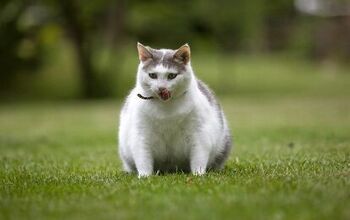How to Tell If Your Hamster Is Overweight (and What to Do About It)

When we bring a hamster into the home, we quickly fall in love with the cute, fluffy little ball of energy. We focus on providing everything they need to live their best little lives, including providing a safe habitat, a healthy diet, and plenty of enrichment. However, there’s one common health concern that’s often overlooked – obesity.
While a hamster’s chubby cheeks are part of their charm, being overweight can lead to serious, life-shortening health issues.
In this post, we’ll share how to identify if your hamster is carrying a little too much weight, the common reasons for weight gain, and, most importantly, tips for creating a clear action plan to help your furry friend live their longest, happiest, and healthiest life.
Why is an Overweight Hamster Concerning?
It’s easy to look at a plump hamster and simply think they’re well-fed and happy. But beneath that cute, round exterior lies the potential for health risks that can significantly impact their quality of life and reduce their lifespan.
Just like in humans, carrying around excess weight puts a strain on your hamster’s tiny body. This can lead to a long list of medical issues and complications. Understanding these potential dangers is the first step toward preventing them and keeping our little friends safe.
Diabetes
One of the most significant risks for overweight hamsters, particularly for certain species such as the Djungarian hamster, is diabetes. An unhealthy diet high in sugar and fat can lead to insulin resistance. This disturbance in insulin levels can progress to diabetes. The warning signs can be subtle at first, including increased thirst and urination. If left unmanaged, it can lead to cataracts, kidney failure, and a host of other problems.
Strained Joints and Organs
That extra padding isn’t just external. It’s also collecting around the vital organs. Over time, this extra fat can lead to heart and liver disease, compromising their function and making your hamster more susceptible to other illnesses.
Furthermore, your hamster’s tiny skeleton is not designed to carry a lot of extra weight. An overweight hamster may develop joint problems, making it difficult for them to move around, climb, or even run on their exercise wheel. This lack of mobility and exercise creates a vicious cycle where a less active hamster gains even more weight, further compounding the problem.
Shortened Life
Ultimately, all of these health issues combine to shorten your hamster’s life and diminish its quality. A hamster that is in pain, out of breath, or unable to move freely is a far cry from the active, curious little creature they are meant to be. The goal of any pet parent is to provide a long, happy life, and addressing their weight issues is a key part of that commitment.
How to Tell if Your Hamster is Overweight
Determining if your hamster is overweight isn’t just about stepping on a scale (although weighing them could be part of the process). Instead, it’s a process of careful observation, combining what you see with a gentle touch. Think of yourself as a detective, looking for cues that their body is carrying a little more weight than it should.
The Visual Check
The first and easiest step is simply to look at your hamster. An ideal body shape for most hamster species is a sleek, pear-like shape. From above, you should be able to see a distinct narrowing behind their shoulders, with the body then becoming lightly wider around the hips. Of course, this will vary from species to species. There are also notable differences between hamsters and dwarf hamsters.
An overweight hamster, on the other hand, will have a body that is consistently round from head to tail, with no visible waist. You may notice their sides bulging noticeably when they sit. Keep in mind that a hamster with full cheek pouches can look bigger, but this is a temporary state! The key to deciding is looking at their body shape when their pouches are empty.
The Touch Test
For a more accurate assessment, you can perform a gentle touch test. Known as palpation, this approach is used by veterinarians and small animal experts. When your hamster is feeling calm and relaxed, gently run your fingers along their sides. In a healthy hamster, you should be able to easily feel their ribs, hip bones, and spine with a thin layer of fat over them. If you have to press firmly to feel these bones, or if you can’t feel them at all because of a thick layer of fat, it’s a strong indicator of excess weight.
Of course, there is also the other extreme. If their bones are easily felt without any fat over them, your hamster may be underweight. This is also a serious concern that requires a vet visit.
Behavioral Clues
Beyond their physical appearance, your hamster’s behavior may also provide valuable clues that something is “off.” Is your hamster’s activity level dropping off? A healthy hamster is an active hamster, and a significant drop in their use of a wheel or their interest in climbing and exploring their surroundings could be a sign that their weight is making it difficult to move.
Another sign they may be struggling with their weight is that they fail to keep up with their grooming needs. An overweight hamster may not be able to reach all areas of their body, resulting in a dull or unkempt coat.
In more serious cases, you may even notice labored or heavy breathing after even the lightest activity.
The Weight Scale
While visual and behavioral cues are crucial, you can use a small digital kitchen scale as a tool for monitoring your hamster’s weight over time. Weigh your hamster at the same time each week and record the results. The single number at any one time isn’t the most important data here; it’s the trends over time and the direction their weight is moving. Keep this information in a detailed journal along with any notes about behavioral changes or other signs of trouble.
A sudden increase in weight could be a sign of a medical problem. A gradual increase over a few months is more likely to be a sign that your hamster would benefit from a change to their diet or daily exercise.
Uncovering the Reasons for Your Hamster’s Weight Gain
Once you’ve determined that your hamster is, in fact, carrying extra weight, the next step is to figure out why. In most cases, the reasons are related to diet and exercise. However, sometimes, a medical issue could be at play. Becoming a detective, observing your hamster’s lifestyle, and partnering with your veterinarian will help you pinpoint the cause and create a tailored solution.
Dietary Factors
For most hamsters, weight gain comes down to a simple imbalance between the calories they are eating and the energy they expend.
- Treat Overload: The “treat trap” is an easy one for loving pet parents to fall into. Those tiny, sugar-rich yogurt drops, sunflower seeds, or sugary fruit pieces may seem small, but they can really add up for a hamster. A few treats here and there can quickly lead to a large calorie intake, sabotaging an otherwise healthy diet.
- Inappropriate Food Mix: Not all hamster foods are created equal. Some seed mixes are high in fatty fillers, such as corn and sunflower seeds, and low in essential nutrients. A balanced diet should primarily include a high-quality, fortified food mix or pellets, with seeds and nuts serving only a small part of their overall daily intake.
- Free-Feeding: Although this approach seems convenient, providing an unlimited supply of food can lead to overheating. Like people, not all hamsters have self-control when it comes to their eating habits, and some will eat more than they need simply because it’s available. A measured, daily portion is often the best way to ensure your hamster gets the right amount of nutrients without overdoing it.
Lack of Exercise
Just like us, a laid-back and low-activity lifestyle can lead to weight gain in hamsters, regardless of how good their diet is.
- Wrong-Sized Wheel: The hamster wheel is a critical piece of equipment. If it’s too small, your hamster’s back will be forced into an unnatural curve. This can be painful and discourage them from using it. A proper wheel should allow them to run with a straight back. For Syrian hamsters, this means a wheel of at least 10-12 inches in diameter, and for dwarf species, a wheel of at least 8 inches in diameter.
- Boredom and Cage Size: A hamster that is bored or confined to a small, unstimulating cage won’t be motivated to move around throughout their day. Providing a suitably-sized cage with multiple levels, tunnels, and toys encourages natural exploration and foraging behavior.
Medical Issues
While less frequent, it’s crucial to rule out underlying health problems, especially if the weight gain is sudden or accompanied by other symptoms.
- Metabolic Conditions: Similar to humans, hamsters can develop conditions like diabetes or hypothyroidism, which can cause them to gain weight despite a consistent diet.
- Tumors or Cysts: A sudden, rapid increase in weight on one side of the body, for example, could be a sign of a non-cancerous growth or a tumor.
If you have made appropriate changes to your hamster’s diet and exercise routine but their weight isn’t changing, or if you notice any other concerning symptoms, a visit to your small-animal veterinarian is essential. They can help you determine if a medical concern is responsible for their weight.
How to Help Your Hamster Reach a Healthier Weight
Now that you’ve identified the root cause, it’s time to create a personalized action plan to help your hamster reach and maintain a healthier weight. Remember, the goal isn’t sudden weight loss! The healthiest way for your hamster to lose weight is a gradual, consistent change. A slow and steady approach is safer and more effective.
Dietary Changes
The most impactful changes you can make for a healthier lifestyle start in your hamster’s food bowl.
- Portion Control: Instead of free-feeding, measure out a specific amount of food each day. To determine the right amount, carefully read the feeding recommendations for the specific food or consult your veterinarian.
- Upgrade Their Food: Choose a high-quality, pellet-based food or a food mix with a fat content of less than 10%. Look for foods that are fortified with vitamins and minerals. These foods provide balanced nutrition without the excess calories and fats found in some seed-heavy mixes.
- Treat Smarter: Re-evaluate your treat routine. Instead of sugary drops or high-fat seeds, consider switching to healthier alternatives. Small pieces of hamster-safe vegetables, such as carrots, broccoli, or bell peppers, are excellent options. You can also offer a tiny piece of protein, like a boiled egg white or a mealworm. These treats should be given in moderation, no more than twice a week.
- Encourage Foraging: Rather than just handing over your hamster’s food in a bowl, make them work for it. Scatter the food around the cage. This encourages natural foraging behavior, which provides mental stimulation and physical activity. Alternatively, consider introducing a foraging puzzle.
Encourage More Physical Activity
A healthy diet is only half the battle. The other half is a stimulating environment that encourages daily movement.
- The Right Wheel: Ensure your hamster has a properly sized exercise wheel with a solid surface to prevent injuries. A larger wheel will encourage more running while providing better back support.
- Out-of-Cage Time: Supervised play time in a hamster-proofed playpen or a secure room is a great way to increase activity. Provide tunnels, toys, and other objects to explore, which will keep them moving and engaged.
- Enrichment is Key: Enrich your hamster’s habitat with climbing toys, platforms, and a deep layer of bedding for burrowing. The more interesting their environment is, the more active they’ll be.
Monitor Their Progress
Change takes time. Don’t expect to see results overnight. Continue to weigh your hamster on a weekly or bi-weekly basis and log their weight. This will help you see if your current plan is working. Remember: A healthy weight loss for a hamster is slow and steady. Rapid weight loss can be dangerous, so if you notice a sudden drop, consult your veterinarian.
Small Changes, Big Impact for Your Hamster
The love we have for our pets drives us to give them the best life possible. For our hamsters, that includes being mindful of their weight. It’s easy to get lost in your day-to-day routine and not notice the subtle signs of weight gain. Being committed to careful observing and tracking their weight can make all the difference.
These small, consistent efforts (from switching to a healthier treat to ensuring their wheel is the right size) add up to a longer, happier, and more vibrant life for your hamster!
Join the PetGuide community. Get the latest pet news and product recommendations by subscribing to our newsletter here.

Britt Kascjak is a proud pet mom, sharing her heart (and her home) with her “pack” which includes her husband John, their 2 dogs – Lucifer and Willow – and their 3 cats – Pippen, Jinx, and Theia. She has been active in the animal rescue community for over 15 years, volunteering, fostering and advocating for organizations across Canada and the US. In her free time, she enjoys traveling around the country camping, hiking, and canoeing with her pets.
More by Britt
























